La Earthcache : La Pierre Branlante de la Verrie
La Earthcache :
La légende :
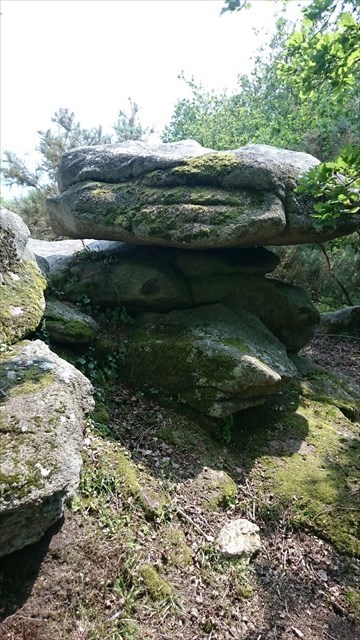
Les dénominations de pierre branlante, pierre tournante, pierre tournoise, pierre tremblante, pierre-qui-vire, s'appliquent non seulement à celles qu'un effort peut faire osciller, mais encore à celles qui selon certaines croyances populaires se mettent d'elles-mêmes en mouvement certains jours ou certaines nuits de l'année, (Noël, veille de la Saint-Jean).
D’après la légende, la Pierre branlante de la Verrie, vire sur elle-même le 25 décembre, entourée d'un cercle de lumière. Des lutins androcéphales forment autour des rondes burlesques pendant une partie de l'hiver.
La pierre branlante de La Verrie est un de ces énormes blocs de pierre brute (granulite), dominant le vallon d'une cinquantaine de mètres et dont les formes étranges ne sauraient être attribuées à l'intervention humaine. Une pression assez forte la fait effectivement osciller. Les cuvettes et les "rigoles d'écoulement" qu'on remarque à sa surface auraient servi d'autel pour les sacrifices...
Certaines pierres du site ont été réutilisées au début du siècle dernier pour construire une sorte de dolmen, sur lequel on trouve aujourd’hui une statue du Christ.
The denominations of rocky stone, revolving stone, stone tournois, stone trembling, stone-qui-vire, apply not only to those that an effort can oscillate, but also to those that according to some popular beliefs are put from them -moving on certain days or nights of the year (Christmas, Eve of Saint John).
According to legend, the rocky stone of the Verrie, turns on itself on December 25, surrounded by a circle of light. Androcephalic elves form around burlesque rounds during part of the winter.
The rocky stone of La Verrie is one of those enormous blocks of rough stone (granulite), dominating the valley of about fifty meters and whose strange forms can not be attributed to human intervention. A strong enough pressure actually makes it oscillate. The cuvettes and the "trickles of flow" which one notices on its surface would have served as altar for the sacrifices ...
Certain stones of the site were reused at the beginning of the last century to build a kind of dolmen, on which one finds today a statue of Christ.
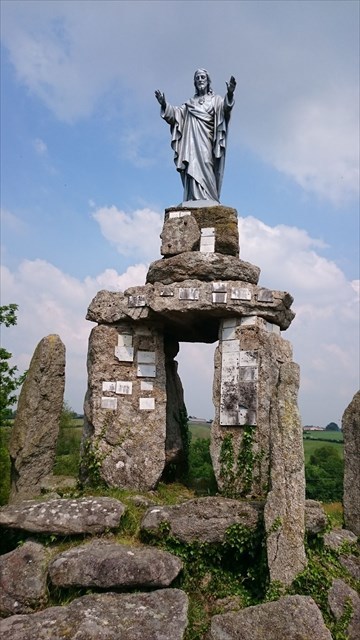
Présentation du granite :
Une petite présentation de la roche est tout d’abord nécessaire.
Le granite est une roche magmatique à structure grenue (formée de grains), entièrement cristallisée et dont les cristaux sont bien visibles à l’œil nu (phénocristaux). Le mot « granite » vient d’ailleurs du latin granum, grain.
Ces minéraux en grains sont de plusieurs natures :
•du quartz principalement (c’est de la silice pure SiO2)
•des micas : ce sont des minéraux feuilletés. On a essentiellement du mica noir (ou biotite) mais aussi du mica blanc (ou muscovite). Le mica blanc est surtout riche en aluminium et en potassium alors que le mica noir est surtout riche en magnésium, en potassium et en fer.
•des feldspaths : feldspaths potassiques (orthose, microcline..) et feldspaths plagioclases (albite, anorthite..).
•un certain nombre d’autres minéraux peuvent aussi se rencontrer dans le granite. On peut citer : hornblende, grenats, magnétite, apatite, zircon…
A small presentation of the rock is first necessary.
Granite is a magmatic rock with a granular structure (formed of grains), entirely crystallized and whose crystals are clearly visible to the naked eye (phenocrysts). The word "granite" comes from elsewhere from the Latin granum, grain.
These minerals in grains are of several natures:
• mainly quartz (it is pure silica SiO2)
• micas: they are laminated minerals. We have mostly black mica (or biotite) but also white mica (or muscovite). White mica is especially rich in aluminum and potassium while black mica is especially rich in magnesium, potassium and iron.
• feldspars: potassic feldspars (orthoclase, microcline, etc.) and plagioclase feldspars (albite, anorthite, etc.).
• a number of other minerals can also be found in granite. We can mention: hornblende, garnets, magnetite, apatite, zircon ...
Altération du granite
Les principaux agents d’altération sont :
• l’eau : elle agit de deux façons. D'abord par hydratation (addition d’eau à un composé sans modification chimique de celui-ci). Chez les micas par exemple, l'eau peut se glisser entre les feuillets du minéral, provoquer son gonflement, ce qui va peu à peu désolidariser les grains de la roche. L'eau agit aussi par hydrolyse (décomposition d’une substance sous l’action de l’eau).
• les végétaux qui ont pu s’implanter à la surface du massif (action des racines dans les diaclases et action des molécules organiques issues de la décomposition de ces végétaux)
Chacun des minéraux du granite réagit différemment à l’altération :
- Le mica noir (ou biotite)
A cause de la présence de fer dans sa composition, il va se transformer assez rapidement en hydroxyde de fer et en argile.
- Le mica blanc (ou muscovite)
Il ne s’altère guère. Il va d'abord se fragmenter en petites paillettes de même composition chimique : la séricite. Une hydrolyse est cependant possible qui conduira par perte de potassium à de l'illite puis à de la kaolinite ou à des smectites selon les conditions.
- Le quartz
Il est inaltérable. Une fois séparé des autres éléments, il fournit l'essentiel du sable
- Les feldspaths
Par hydrolyse, ils vont se transformer en argiles (illite, kaolinite, gibbsite, smectites…). Selon les conditions, ces hydrolyses pourront se faire selon des réactions différentes et donc conduire à des composés différents. De plus tous les feldspaths ne sont pas sensibles de la même façon à l'hydrolyse (les feldspaths potassiques sont les plus résistants ; puis viennent les feldspaths sodiques et enfin les feldspaths calciques).
Les phénocristaux, présents dans certains granites, résisteront mieux à l'altération.
L’arène granitique pourra par la suite être emportée par le vent, la gravité et les eaux de ruissellement, dégageant progressivement les blocs de granite non altérés qui resteront empilés les uns sur les autres créant dans le paysage ces structures appelées chaos.
On peut résumer ce phénomène ainsi :
The main agents of alteration are:
• water: it acts in two ways. Firstly by hydration (addition of water to a compound without chemical modification thereof). In micas for example, water can slip between the layers of the mineral, causing its swelling, which will gradually separate the grains of the rock. Water also acts by hydrolysis (decomposition of a substance under the action of water).
• Plants that may have established themselves on the surface of the massif (action of the roots in the joints and action of the organic molecules resulting from the decomposition of these plants)
Each of the minerals in the granite reacts differently to the alteration:
- Black mica (or biotite)
Because of the presence of iron in its composition, it will transform rather quickly into iron hydroxide and clay.
- The white mica (or muscovite)
It does not change much. It will first break into small flakes of the same chemical composition: sericite. Hydrolysis is possible, however, which will lead by loss of potassium to illite then to kaolinite or smectites depending on the conditions.
- The quartz
He is unalterable. Once separated from other elements, it provides most of the sand
- Feldspars
By hydrolysis, they will turn into clays (illite, kaolinite, gibbsite, smectites ...). Depending on the conditions, these hydrolyses can be done according to different reactions and thus lead to different compounds. Moreover, not all feldspars are equally sensitive to hydrolysis (potassium feldspars are the most resistant, followed by sodium feldspars and finally calcium feldspars).
Phenocrysts, present in some granites, will be more resistant to weathering.
The granite arena can subsequently be blown away by wind, gravity and runoff, gradually clearing the unaltered granite blocks that will remain stacked on top of each other creating these structures called chaos in the landscape.
This phenomenon can be summarized as follows :
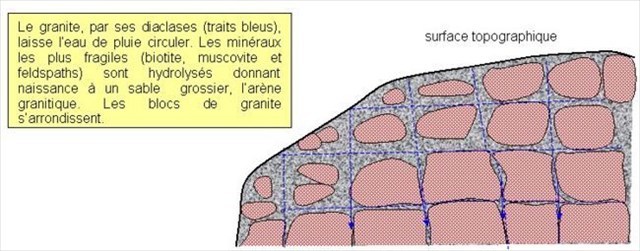
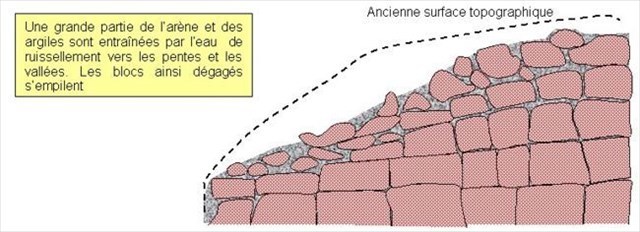
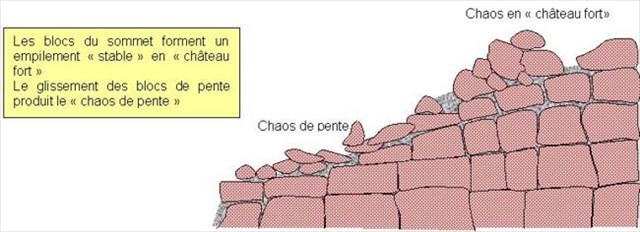
Les questions :
La lecture attentive de la page et un peu d’observation sont normalement suffisants pour répondre aux questions.
Point 1 : La Pierre Branlante :
Question 1 : Décrire le granite, sa composition.
Question 2 : A votre avis, comment s’est formé la pierre Branlante de la Verrie ?
Careful reading of the page and a little observation are normally sufficient to answer questions.
Point 1: The Rocky Stone :
Question 1: Describe granite, its composition.
Question 2: In your opinion, how was formed the Rocky Stone of the Verrie?
Point 2 : La Statue du Sacré Cœur :
Question 1 : Sur un des piliers de granite, côté nord, on remarque des cristaux scintillants, de quel minéral s’agit il ?
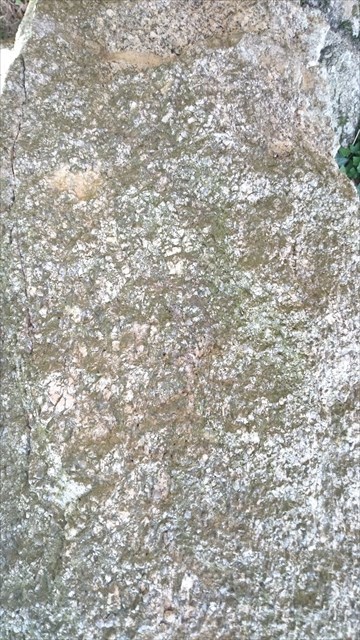
Question 1: On one of the granite pillars, north side, there are sparkling crystals, what mineral is it?
Question 2 : Sur ce pilier de granite, côté est, vous voyez un morceau de roche différent du reste du bloc sous la zone rouge, de quel minéral s’agit-il?
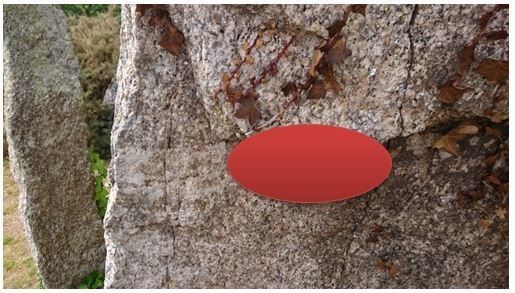
Question 2: On this granite pillar, east side, you see a piece of rock different from the rest of the block, what mineral is it?
Loguez cette cache « Found it » et envoyez-moi vos propositions de réponses soit via mon profil, soit via la messagerie geocaching.com (message center), et je vous contacterai en cas de problème.
Une photo de vous ou de votre GPS seraient la bienvenue, mais ne sont pas obligatoire.
Log this cache "Found it" and send me your proposals for answers either via my profile or via the messaging geocaching.com (message center), and I will contact you in case of problems.
A photo of you or your GPS would be welcome but are not mandatory.
Rappel concernant les « Earthcaches »: Il n'y a pas de conteneur à rechercher ni de logbook à renseigner. Il suffit de se rendre sur les lieux, de répondre aux questions ci-dessus et de nous renvoyer les réponses.
Reminder concerning "Earthcaches": there is neither a container to look for nor a logbook to sign. One need only go to the location, answer to the differents quiestions and send us the answers.
Sources :
http://geobiophile.over-blog.com/article-la-pierre-branlante-de-la-verrie-85-104116982.html
http://www.geowiki.fr/index.php?title=Altération_du_granite